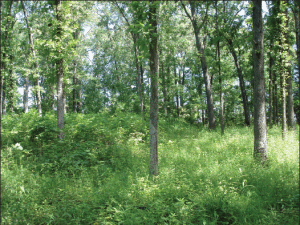Green Horizons
Volume 19, Number 2Spring 2015
Managing Open Forests for Wildlife and Timber
FRANK R. THOMPSON III | U.S. Forest Service Research Wildlife Biologist
JOHN KABRICK | U.S. Forest Service Research Forester
Open forests, also referred to as woodlands and savannas, have more open canopies and lower tree densities than closed canopy forests. These transitional communities were once widespread and common throughout the Midwest, but after European settlement, most were either converted to other land uses or fire suppression resulted in their succession to closed-canopy forests.
 |
Photo courtesy of Rich Guyette |
| An open woodland demonstrating excellent groundcover for wildlife species and large-crowned trees for mast production. |
How open a condition you manage your forest for and the tools that you use will also depend on non-wildlife objectives such as timber. Where timber is also an important objective, thinning to remove the smallest and least desirable trees in the midstory and understory and leaving only the largest trees with full crowns will create stands with small gaps in the overstory and an open understory. This will provide light to the ground to stimulate the growth of the herbaceous plants and will accelerate the growth rate of the remaining trees much like any other timber stand improvement (TSI) practice. The application of herbicide during the thinning will prevent the production of stump sprouts, keeping the understory open longer. Prescribed fire can be used judiciously to remove leaf litter and to periodically burn off tree seedlings and shrubs in the understory. Care must be taken not to damage the timber with prescribed fire by burning on calm days when fuel moisture and relative humidity are high.
Where open woodland or savanna conditions are desired for wildlife, tree removals can include some of the larger overstory trees that ordinarily would be retained for timber production. Because the open conditions will favor the development of a woody understory, prescribed fire may need to be applied on a regular basis-once every three to five years-to burn off the woody regrowth and maintain an open understory. The combination of prescribed fire and open stand condition will stimulate the growth of a diverse array of forbs and grasses that are beneficial to wildlife species adapted to open forests. For assistance with managing open forests, contact a professional forester.